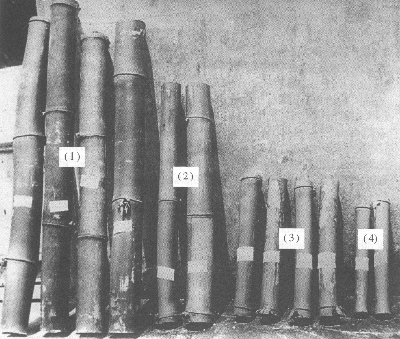| What is Tamboo Bamboo? Tamboo is from the French word tambour which means drum. Bamboo is a member of the grass family. It grows at an incredible rate, indeed it is among the fastest growing plant on land. Bamboo like all other plants takes in carbon dioxide (CO2) and gives off Oxygen (O2). In the sunlight physiological activity takes place within the plants - as it produces sugars and starches in the process of photosynthesis. It is said when one cuts the bamboo plant in sunlight, the stems are more vulnerable to termites, fungus and general rotting processes. The best time to cut the bamboo is either 3 days before or 3 days after the date of the new moon . This is refers to as "dark of night". The reason is that bamboo stores water and when the earth's water is at it lowest point it makes it easier to cut the bamboo stems and prevents from rotting easily. The bamboo is allowed to dried out for a week or more before being prepared. |
| Background Information: The tamboo bamboo ensemble, in spite of its rough and rude appearance must be recognized that tamboo bamboo played a very vital and important role in the ultimate development of the pan (steel drum). Tamboo bamboo has been part of Trinidad and Tobago's music celebration for over five decades. Tamboo Bamboo requires extraordinary techniques and dexterity in playing various instruments. Tamboo bamboo music was played by the African population for stick-fights, folk dances such as bongo and Dame Lorraine, in wakes and revelries especially at Carnival. On many occasions on Carnival days, brass bands or string bands found themselves playing alongside a tamboo bamboo band. At first the musicians would complain about the unmelodic noise made by the tamboo bamboo bands. Not being able to do anything about it, thus, many string bands and brass bands sometimes joined forces with the tamboo bamboo bands. The experience gained by the tamboo bamboo men through the union of bamboo and other musical instruments led them to substitute many other objects into the band to replace destroyed tamboo bamboo which often broke on the road through pounding. This experience served the country's musicians into the development and evolution of the pan in which we know it today. |
| Instruments: The instruments of the tamboo bamboo bands were made of bamboo stems of different sizes weights, widths and lengths. Tamboo bamboo bands were purely rhythmic ensembles comprised of a sufficient 'mix' of sounds to achieve tonal balance. 
Tamboo Bamboo Instruments 1) Bass or Boom 2) Foule or Fullers 3)Cutters 4) Chandlers image courtesy of SeeTobago |
| Bottle and Spoon A well-remembered feature of the tamboo bamboo days that survives in practice to this day, is the playing of bottle-and-spoon. While the tamboo bamboo bands provided accompaniment to the rhythmic, often syncopated singing and chanting at large, open air celebrations, bottle-and-spoon became the improvised accompaniment at house parties and small impromptu musical get-togethers. In those early days, the green flask used by a certain Dutch gin manufacturer, was greatly favoured, its thick glass proving most resistant to breaking when "played". Once emptied of their original contents, these flasks or half-bottles would be partly filled with water at different levels and played by rapping with a metal spoon. The result was high-pitched range of musical tones which kept both time and rhythm to the tunes being sung or played. The bottle of spoon in the early days is an example of the "iron" (usually an old motor-car brake drum) in the present day steel orchestra in keeping the rhythmic timing of the tune. The tamboo bamboo and the bottle-and-spoon, are ancestors of today rhythmic instrumentation found in the steel orchestras. |
This site uses frames, if you do not see frames (menu on the left) click here.
Page maintained by www.tntisland.com, Copyright © 1996-2025 Last Revised: 06/01/2025.